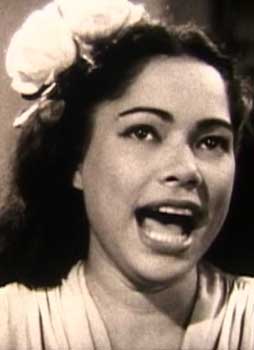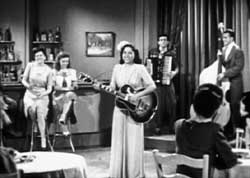 The Mary Kaaihue Trio consists of Mary Kaaihue on guitar, her brother Norman Kahihua on slap bass, & Frankie Ross on accordion.
The Mary Kaaihue Trio consists of Mary Kaaihue on guitar, her brother Norman Kahihua on slap bass, & Frankie Ross on accordion.
Mary is gorgeous with a striking ethnic Hawaiian face. She would in a very few years change the name of their band to the Mary Kaye Trio because of the insurmountable expectation that her little band must do Hawaiian music, which they didn't.
Under the new name she starred in a successful Vegas act & scored a recording contract, which she did not yet have when she made three soundies in 1945.
In Stuff Like That There (1945) she's playing a big Martin guitar & singing a great boogy-woogie number in a style that amounts to pre-rock rock n roll.
The trio's performing in a set dressed up to look like a malt shop. Frankie Ross gives a rockin' accordion solo & even though I still can't say I much like the accordion, I can see why when rock first started out, this instrument was considered useful & cool rather than only suited for nerdy polka.
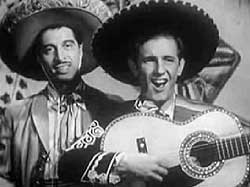 With a title like Mexican Hat Dance (1941) I was prepared for a totally stereotyped portrait of Mexicans, & pretty much got it, but it's not a hundred percent bad.
With a title like Mexican Hat Dance (1941) I was prepared for a totally stereotyped portrait of Mexicans, & pretty much got it, but it's not a hundred percent bad.
It opens with some pretty sweet Spanish language singing, showing two guys in cliche mariachi costumes, but that's not so bad when the singer can manage to sound at least a little bit authentic.
The singer is Cliff Ferre, a Broadway hoofer, singer, & actor. A decade or so later he was recording "blue" records for adult parties. After some minor movie & television acting in the early '50s he became more of a businessman at ASCAP.
The film cuts to a beautiful woman doing a pin-up pose in a window. She's billed only as "Marchetta," though I wondered if she was really Noel Carter, a dancer whom Gray Gordon married that very year.
Cliff finishes his reasonably good folksy Mexican number in about a minute, then tosses his hat to the pretty senorita as the Gray Gordon Orchestra plays "Mexican Hat Dance."
The seniorita dances around the rim of the hat for a few seconds before she grabs a tambourine & goes to join the band, doing what most resembles a gypsy dance.
Gray Gordon is the guy in the faux mariachi band playing saxophone. Although this band weren't really mariachis, they've taken the music seriously & not camped it up too much.
For better or worse, this was to be one the last of the Gray Gordon recordings, as the band was past its heyday of the 1930s, with Gordon's health in decline. Mexican Hat Dance is not really representative of his band's music, except in showing they were fair to good.
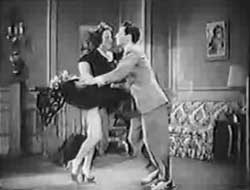 As saccharine violins rise, the camera focuses on a blank-book held open by a woman's hand. She imagines a man behind a stearing-wheel superimposed momentarily on the page. It's Ray Hirsch, playing the title role of Georgie Porgie (1946).
As saccharine violins rise, the camera focuses on a blank-book held open by a woman's hand. She imagines a man behind a stearing-wheel superimposed momentarily on the page. It's Ray Hirsch, playing the title role of Georgie Porgie (1946).
Next thing you know, an unidentified gal is singing "Georgie Porgie puddin' pie/ With a twinkle in his eye/ Kissed the girls & made 'em cry/ Georgie Porgie what a guy."
The song kinda sucks & the unknown singer, though fresh-faced & innocent looking, has something wrong with her eyes likely due to all that glue from the fake eyelashes, rendering her ghastly to look at in the close-ups, creepier still when she gives the viewer a wink.
The film cuts to other women in what must be a sorority house, getting dressed in other apartments. One of the girls is shown naked behind the fogged glass door of a shower, washing her hair. Only later will we discover this is Patty Lacey.
Her posture & the shower door & the rest of the room are actually not a bad composition photographically speaking, even if the commercial purpose of sticking in lots of girls in private moments of undress was to get the sleeze factor since sex sells.
Georgie arrives in his fancy automobile, wearing a hep zoot suit & a big smile. The singer & her roommate, overcome with delight, run out of their apartment to go greet him.
Not just those two gals, but all the others we glimpsed in the apartment house rush out to meet him in the entryway at the foot of the stairs.
The girl from the shower, still zipping into her dress, slides down a bannister into the whole mess of girls, to be grabbed & whirled around by Georgie.
The other women back away into a circle so Georgie & shower-girl can do an absolutely stunning dance routine. By now it's obvious this is a "dancie" more than it is a soundie & Ray Hirsche & Patty Lacey cut that rug to pieces.
A black maid is tossed in near the end to join in the dancing, & all the girls are excited, though Georgie has the good sense to dance only with Patty.
This is one odd little film, with its last-scenes introduction of a stereotypical maid; Georgie's pimp-like familiarity with all the girls in the building; the sexual teasing especially the shower scene; & the curiously anonymous singer with the creepy eyes...
But it's that frenzied dance following the slide down the bannister that matters, & that part's great.
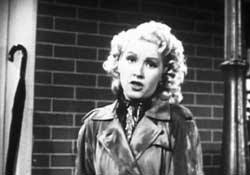 Kathryn "Sugar" Kane was a blonde bombshell whose face the camera loved. She sings a song introduced in the 1930s by Ethel Waters at the Cotton Club, & by Lena Horne in a feature film which shares the title of the soundie Stormy Weather (1942). Sugar is backed by the unseen Darrell Calker & His Orchestra.
Kathryn "Sugar" Kane was a blonde bombshell whose face the camera loved. She sings a song introduced in the 1930s by Ethel Waters at the Cotton Club, & by Lena Horne in a feature film which shares the title of the soundie Stormy Weather (1942). Sugar is backed by the unseen Darrell Calker & His Orchestra.
Considering the competition of great singers who had covered this song, Sugar holds her own, a decent version, singing it at the bottom of her vocal register.
The stage is decked out to look like a street scene against a brick wall, next to the entrance to a club. She's wearing a raincoat, & in the entrance to the club is a hat-check window or in this case umbrella-check.
Its raining though Sugar's got no umbrella & her hair isn't getting wet; let's pretend there's an awning above her just out of the camera's eye, so that it'll makes better visual sense.
With a jump-cut to a cityscape (further stage right than previously visible) the rain is now much more in evidence, with pedestrians hunched under their umbrellas, & another cut to lightning in the sky. Through the instrumental we see how amazingly stormy it is, couples meeting even in the rain, except for sad-faced Sugar looking oh so lonely while the hard rain continues not to get her wet.
There's a big-movie cinematic look to this three-minute soundie, & a fine central performance. Sugar should've been much better known, but real stardom evaded her. She appears in a tiny handful of films, none particularly significant, though she stars in the Vitaphone musical short Swingtime in the Movies (1938) which had an Oscar nomination.
Stormy Weather is included in the Castle Films one-reel home-movie Swing Syncopation (1947) along with Marlyn Stewart's At a Little Roadside Rest (1941) & the goofy dance soundie Little Dutch Mill (1942).
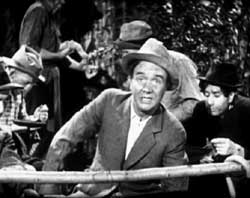 Broadway "patty" singer Clarence Nordstrom is the lead vocalist among the tramps shown in the hobo camp, singing Fifty Thousand Dollars (1941), backed by the unseen Jack Shilkret Orchestra, more or less a soundies house band in 1941 & 1942.
Broadway "patty" singer Clarence Nordstrom is the lead vocalist among the tramps shown in the hobo camp, singing Fifty Thousand Dollars (1941), backed by the unseen Jack Shilkret Orchestra, more or less a soundies house band in 1941 & 1942.
It's a rather misogynist comedy number, the hobo claiming he came to this condition because he met a girl & ended up paying fifty thousand dollars for a kiss.
In a flashback sequence we see Clarence in better times, dapper & flirtatious in the park with a girl who flirts right back. With stereotypical Irish accent he sings:
"Oh she gave me smiles & glances/ That encouraged my advances/ Yet I thought she was a simple country miss/ She had such a lovely touch/ But just one touch got me in dutch/ I paid fifty thousand dollars for a kiss."
In further flashbacks we see how he was sued by the miss, who told the judge she'd been a pure maiden led astray by a bad man, then crossed her legs seductively, so that the judge got all aroused & awarded her fifty thousand.
So hobos came about not from the Depression, not from unemployment or alcoholism, not from criminality nor even adventure, but from being framed by evil good lookin' babes.
copyright © by Paghat the Ratgirl
|
